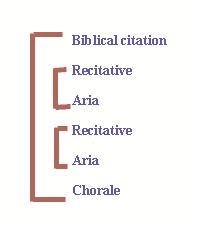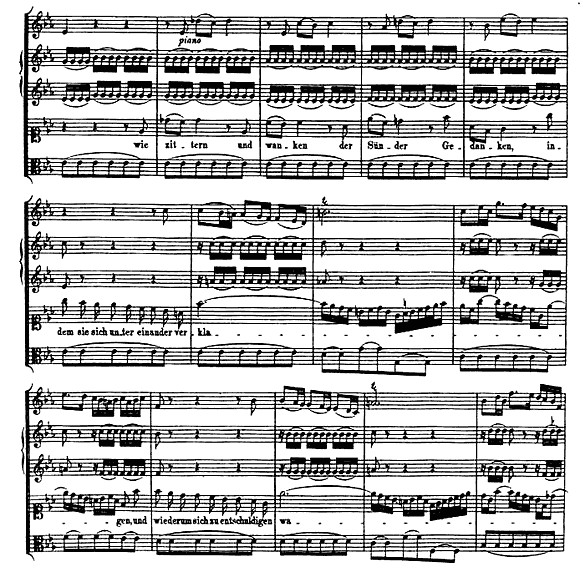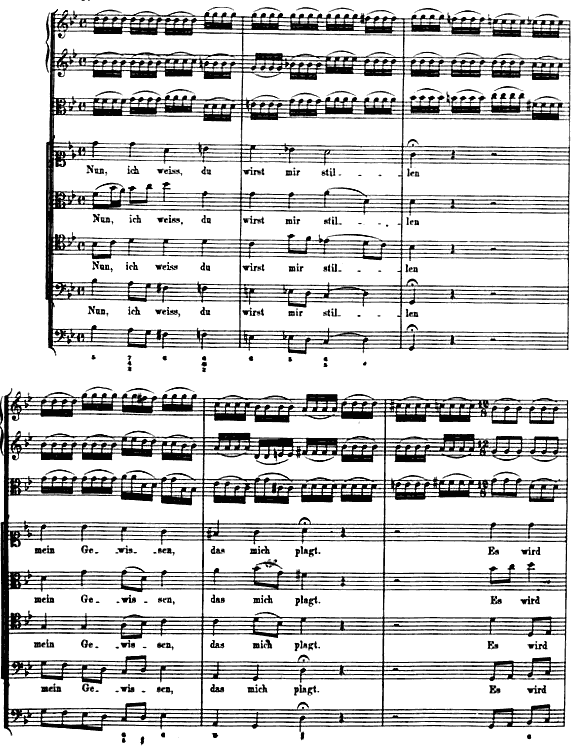This cantata was written for the Ninth Sunday after Trinity, a common occasion in the Christian church calendar. (Two other cantatas by Bach were also written for that feast, BWV 94, Was frag ich nach der Welt, and BWV 168, the solo cantata Tue Rechnung! Donnerword!) The work was first performed on July 25, 1723, during Bach’s time in Leipzig. The text of the cantata is anonymous. The movements are summarized as follows:
| Movt. | Scoring | Meter/tempo | Key | Texture |
| Chorus | SATB, plus horns, oboes, strings, continuo | 4/4 adagio; then 2/2 allegro | g minor | Polyphonic; then a fugue |
| Recitative | Alto solo and continuo | 4/4 | c minor to B-flat | Homophonic |
| Aria | Soprano solo, oboe, upper strings (no cello or continuo!) | 3/4, moderate to slow | E-flat | Homophonic |
| Recitative | Bass solo, strings, continuo | 4/4 | B-flat to E-flat | Homophonic |
| Aria | Tenor solo, horn, strings, continuo | 4/4,moderate tempo | B-flat | Homophonic, with active orchestral parts |
| Chorale | Tutti | 4/4 | B-flat | Homophonic |
Accord to Dürr, the form of this cantata is common to several cantatas from Bach’s early Leipzig years:

Eric Chafe, who has written a whole book on Bach’s vocal music (Tonal Allegory in the Vocal Music of J.S. Bach [Berkeley and Los Angeles: University of California Press, 1991]), says that this cantata is one of many dealing with God’s judgment. We might not quite catch that idea, unless we realize that the Gospel reading (Luke 16:1-9) for the Ninth Sunday after Trinity tells the parable of the unjust steward. Chafe says that Bach uses “rhythmic and metric devices in conjunction with the antithesis of chromaticism/diatonicism to present the complexity of the Lutheran life” (169). That means that modulation to distant keys, especially with several or more flats, with sudden returns to major keys with few flats; the use of chromatic notes help to show our distance from Jesus and our revival through our hope in the Lord.
The opening movement is set in two parts, as you can see from the table above. The opening is very dark adagio, set primarily in g minor, with lots of chromaticism, lamenting appoggiatura figures in the oboe I/horn I part, and occasional strong dissonances. This is consistent with the text, though in the period following Trinity Sunday we might be at such a somber text:
| Herr, gehe nicht ins Gericht mit deinem Knecht |
Lord weigh Thou and judge us not by our default |
This is followed by a fugue, which maintains the serious feel despite a faster tempo and more active texture. Again, the text is the key:
| Denn vor dir wird kein Lebendiger gerecht |
Nay, for then no man alive may Thou acquit. |
After a short recitative, we reach the soprano aria. This third movement is so unusual because it lacks a continuo part! I certainly don’t know all of Bach’s works, but I only know of one other example in which this occurs, and it’s an example many Bach Choir “faithfuls” will immediately recognize – the famous aria, also for soprano, from the St Matthew Passion, “Aus liebe”. In that piece, the lack of continuo represents Christ hanging on the cross without support from his disciples, and with nothing but the nails holding him. Here, I haven’t a clue. I see nothing in the text to indicate the motivation for this unconventional scoring. It does, however, create a light, gentle feel,and perhaps the rational is as simple as that. Here’s an excerpt of the score:

The last movement has an orchestral descant over chorale harmonization, which is fairly uncommon (though it is also seen in Cantatas BWV 25, 46, 69a, 77, 136, and 179). Here, the upper strings (except the cellos/basses, which are on the continuo line) play an animated accompaniment, which is really a means of reinforcing the harmonies and activating the texture. You can see from the example below that these are not particularly interesting parts, and do not have the kind of melodic interest we normally associate with descants, such as those sung by sopranos or played by a trumpet over a hymn in church. Note that the moving lines in the violin are remarkably similar to the trembling violin lines accompanying the soprano in her aria:

What I find more unusual is not this moving part, but the fact that it fills in the space between phrases, something we’re not used to seeing in a closing chorale of a Bach cantata, where each phrase is separated merely by a fermata. Chafe (cited above) focuses on the rhythmic content of this movement, stating that the transformation of the rhythm from common time (4/4) to compound meter (12/8) and changes in the rhythmic subdivision of notes indicates stages of change in the life of Christians (169).










































